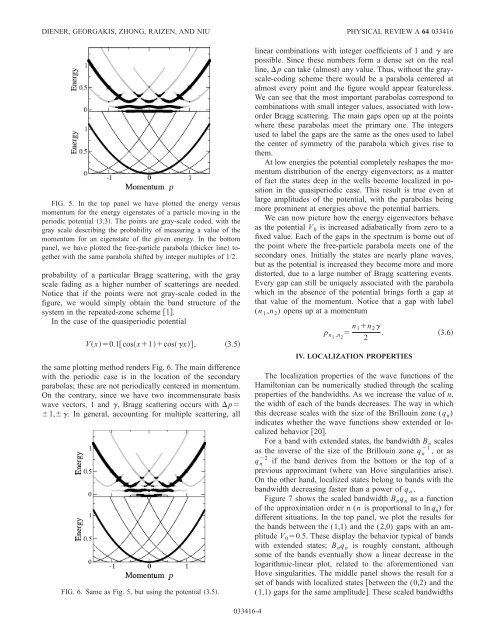Transition between extended and localized states in a one ...
Transition between extended and localized states in a one ...
Transition between extended and localized states in a one ...
You also want an ePaper? Increase the reach of your titles
YUMPU automatically turns print PDFs into web optimized ePapers that Google loves.
DIENER, GEORGAKIS, ZHONG, RAIZEN, AND NIU PHYSICAL REVIEW A 64 033416<br />
FIG. 5. In the top panel we have plotted the energy versus<br />
momentum for the energy eigen<strong>states</strong> of a particle mov<strong>in</strong>g <strong>in</strong> the<br />
periodic potential 3.3. The po<strong>in</strong>ts are gray-scale coded, with the<br />
gray scale describ<strong>in</strong>g the probability of measur<strong>in</strong>g a value of the<br />
momentum for an eigenstate of the given energy. In the bottom<br />
panel, we have plotted the free-particle parabola thicker l<strong>in</strong>e together<br />
with the same parabola shifted by <strong>in</strong>teger multiples of 1/2.<br />
probability of a particular Bragg scatter<strong>in</strong>g, with the gray<br />
scale fad<strong>in</strong>g as a higher number of scatter<strong>in</strong>gs are needed.<br />
Notice that if the po<strong>in</strong>ts were not gray-scale coded <strong>in</strong> the<br />
figure, we would simply obta<strong>in</strong> the b<strong>and</strong> structure of the<br />
system <strong>in</strong> the repeated-z<strong>one</strong> scheme 1.<br />
In the case of the quasiperiodic potential<br />
Vx0.1cosx1cosx, 3.5<br />
the same plott<strong>in</strong>g method renders Fig. 6. The ma<strong>in</strong> difference<br />
with the periodic case is <strong>in</strong> the location of the secondary<br />
parabolas; these are not periodically centered <strong>in</strong> momentum.<br />
On the contrary, s<strong>in</strong>ce we have two <strong>in</strong>commensurate basis<br />
wave vectors, 1 <strong>and</strong> , Bragg scatter<strong>in</strong>g occurs with p<br />
1,. In general, account<strong>in</strong>g for multiple scatter<strong>in</strong>g, all<br />
FIG. 6. Same as Fig. 5, but us<strong>in</strong>g the potential 3.5.<br />
033416-4<br />
l<strong>in</strong>ear comb<strong>in</strong>ations with <strong>in</strong>teger coefficients of 1 <strong>and</strong> are<br />
possible. S<strong>in</strong>ce these numbers form a dense set on the real<br />
l<strong>in</strong>e, p can take almost any value. Thus, without the grayscale-cod<strong>in</strong>g<br />
scheme there would be a parabola centered at<br />
almost every po<strong>in</strong>t <strong>and</strong> the figure would appear featureless.<br />
We can see that the most important parabolas correspond to<br />
comb<strong>in</strong>ations with small <strong>in</strong>teger values, associated with loworder<br />
Bragg scatter<strong>in</strong>g. The ma<strong>in</strong> gaps open up at the po<strong>in</strong>ts<br />
where these parabolas meet the primary <strong>one</strong>. The <strong>in</strong>tegers<br />
used to label the gaps are the same as the <strong>one</strong>s used to label<br />
the center of symmetry of the parabola which gives rise to<br />
them.<br />
At low energies the potential completely reshapes the momentum<br />
distribution of the energy eigenvectors; as a matter<br />
of fact the <strong>states</strong> deep <strong>in</strong> the wells become <strong>localized</strong> <strong>in</strong> position<br />
<strong>in</strong> the quasiperiodic case. This result is true even at<br />
large amplitudes of the potential, with the parabolas be<strong>in</strong>g<br />
more prom<strong>in</strong>ent at energies above the potential barriers.<br />
We can now picture how the energy eigenvectors behave<br />
as the potential V0 is <strong>in</strong>creased adiabatically from zero to a<br />
fixed value. Each of the gaps <strong>in</strong> the spectrum is borne out of<br />
the po<strong>in</strong>t where the free-particle parabola meets <strong>one</strong> of the<br />
secondary <strong>one</strong>s. Initially the <strong>states</strong> are nearly plane waves,<br />
but as the potential is <strong>in</strong>creased they become more <strong>and</strong> more<br />
distorted, due to a large number of Bragg scatter<strong>in</strong>g events.<br />
Every gap can still be uniquely associated with the parabola<br />
which <strong>in</strong> the absence of the potential br<strong>in</strong>gs forth a gap at<br />
that value of the momentum. Notice that a gap with label<br />
(n 1 ,n 2) opens up at a momentum<br />
pn1 ,n <br />
2 n1n 2<br />
. 3.6<br />
2<br />
IV. LOCALIZATION PROPERTIES<br />
The localization properties of the wave functions of the<br />
Hamiltonian can be numerically studied through the scal<strong>in</strong>g<br />
properties of the b<strong>and</strong>widths. As we <strong>in</strong>crease the value of n,<br />
the width of each of the b<strong>and</strong>s decreases. The way <strong>in</strong> which<br />
this decrease scales with the size of the Brillou<strong>in</strong> z<strong>one</strong> (q n)<br />
<strong>in</strong>dicates whether the wave functions show <strong>extended</strong> or <strong>localized</strong><br />
behavior 20.<br />
For a b<strong>and</strong> with <strong>extended</strong> <strong>states</strong>, the b<strong>and</strong>width B n scales<br />
as the <strong>in</strong>verse of the size of the Brillou<strong>in</strong> z<strong>one</strong> q n 1 ,oras<br />
q n 2 if the b<strong>and</strong> derives from the bottom or the top of a<br />
previous approximant where van Hove s<strong>in</strong>gularities arise.<br />
On the other h<strong>and</strong>, <strong>localized</strong> <strong>states</strong> belong to b<strong>and</strong>s with the<br />
b<strong>and</strong>width decreas<strong>in</strong>g faster than a power of q n .<br />
Figure 7 shows the scaled b<strong>and</strong>width B nq n as a function<br />
of the approximation order n (n is proportional to ln q n) for<br />
different situations. In the top panel, we plot the results for<br />
the b<strong>and</strong>s <strong>between</strong> the (1,1) <strong>and</strong> the (2,0) gaps with an amplitude<br />
V 00.5. These display the behavior typical of b<strong>and</strong>s<br />
with <strong>extended</strong> <strong>states</strong>; B nq n is roughly constant, although<br />
some of the b<strong>and</strong>s eventually show a l<strong>in</strong>ear decrease <strong>in</strong> the<br />
logarithmic-l<strong>in</strong>ear plot, related to the aforementi<strong>one</strong>d van<br />
Hove s<strong>in</strong>gularities. The middle panel shows the result for a<br />
set of b<strong>and</strong>s with <strong>localized</strong> <strong>states</strong> <strong>between</strong> the (0,2) <strong>and</strong> the<br />
(1,1) gaps for the same amplitude. These scaled b<strong>and</strong>widths
















